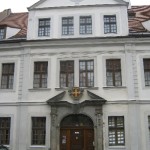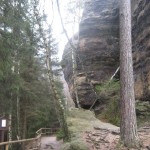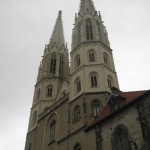On the morning of Friday 21st August 2015, Sybille and I set out from the Pilgerherberge at Gröditz, to walk 20km to the large town of Bautzen. As you can see from the photographs, we were blessed with fine sunny weather.
Our route took us along a series of tracks and minor roads across undulating countryside.

Here is the way approaching the village of Drehsa.

Within Drehsa, there was this fun mural of a flying pig and piglet 🙂

In view of the sunny weather, we both appreciated the shade provided by trees along parts of the route.
As on many pilgrim routes that I’ve walked, the approach to larger towns and cities is often not that pleasant for walkers. The last few kilometres into Bautzen involved walking uphill, alongside a busy main road. But we eventually made it, obtained the key to the pilgrim accommodation provided by the Lutheran Church, where we were able to shower, change and leave most of our belongings securely.

In the early evening, we enjoyed a drink, sitting outside in the main square, opposite the Rathaus.

Nearby is St. Peter’s Cathedral, an example of a simultaneum or Simultankirche. Here Lutherans and Roman Catholics have shared the same Church building since 1530! After exploring more of the historic town centre, Sybille took me a very nice Sorbian restaurant which she had discovered during her pilgrimage earlier in April.

Fortunately, the route out of Bautzen the following morning, was along a series of quite quiet roads, though we did have to pass under the busy Autobahn 4. After 8.5km of walking, we reached the top of Roter Berg, a low hill on which has been erected the Milleniumsdenkmal featuring St Cyril and St Methodius, Apostles to the Slavs. Methodius was made a bishop therefore he is the one wearing a mitre 🙂

That afternoon, we walked on a further 8.5km, to the town of Crostwitz. Just outside the town, the correct way was indicated by a yellow arrow, painted on the road!
 |
 |
In Crostwitz, we stayed overnight in this Pilgerherberge owned and run by a lady called Monika. She is a native speaker of Sorbian, the West Slavic language I mentioned in my previous post. In Crostwitz, the secondary/high school, teaches through the medium of Sorbian, with German only being taught as a second language.
Monika explained that when this area was part of the Soviet satellite state of East Germany, the communist authorities actively encouraged the use and preservation of the Sorbian language. This was because of it being a Slavic language and so much of what happened was orchestrated by the Russians in Moscow, their ‘fellow Slavs’ 😉 It is ironic that now, one place where the language continues in active use, is within the Church. On the evening of Saturday 22nd August 2015, Sybille and I went to a very well-attended mass in the Roman Catholic Parish Church, conducted only in Sorbian.

Believe it or not, despite only being spoken by about 50,000 people, there are two different versions of Sorbian! About 40,000 people speak Upper Sorbian and live in the Bundesland of Freistaat Sachsen, the area we were walking through. Immediately north, in the Bundesland of Brandenburg, there are a further 10,000 speakers of Lower Sorbian. Upper Sorbian relates more to Czech; Lower Sorbian to Polish.
Our final day on this first part of the Ökumenische Pilgerweg was Sunday 23rd August 2015, when we walked 16.5km from Crostwitz to Kamenz. Once more it was fine and sunny and my main recollection of that day, was finding nowhere that was open to serve us a cool drink! Fortunately, when we reached the eastern outskirts of Kamenz, we had to walk right through where a travelling fair was set up for a week and we finally were able to purchase a couple of beers.
 |
 |
We then walked on to the town centre to the tourist information centre, where we collected the key to the Pilgerherberge. Following that, we treated ourselves to a further beer, sitting outside a hotel on the town square, opposite the Rathaus. One problem we encountered throughout our week on the Ökumenische Pilgerweg, were an abundance of wasps, who tended to take a great interest in any beer we were drinking. This was a novel way of preventing them doing so 🙂
My other recollection of the whole week was the almost total absence of anyone who spoke English. My normal experience of trying to use my limited German when in Germany, is being spoken back to in word-perfect English! But the first time this happened to me during our five days on the Ökumenische Pilgerweg, was in Kamenz, ordering this beer and a different one for Sybille, who had gone off to use the toilet facilities in the hotel. I presume the reason for the lack of English was being in the former East Germany and being places not normally frequented that much by non-German tourists.

Suitably refreshed, we then walked on a further kilometre uphill 🙁 , to the Kamenz Pilgerherberge.
 |
 |




Hi Ricky,
Thank you for this collection of posts describing your adventures on the Okumenisches Pilgerweg, as usual your photographs are a wonderful accompaniment; in the photos of the fields and shaded paths I can almost smell the fresh air! The images of the architecture in both Germany and Poland and your mention of Upper and Lower Sorbian and their similarities to Czech and Polish remind me that we Europeans are a wonderfully intermingled and inter related community of nations, languages, faiths, cultures and peoples – please God we don’t lose sight of our unity and find ourselves going back into the awfulness we’ve inflicted on ourselves and others over so many centuries. I wish you, Sybille and your congregation a very happy Easter, Veselé Velikonoce Ricky.
Hi Sean,
Thank you for visiting & commenting once more. Glad you enjoyed the three posts & the photographs. I concur completely with the sentiments expressed in the central part of your comment & thank you for your Easter greetings which are reciprocated.
I concur with Sean – a lovely trio of very interesting and beautifully-illustrated posts. As a linguist it pains me to confess that I’d never heard of Sorbian before you mentioned it in your second post. Its survival due to Russian influence makes sense and it was the same Russian influence which meant that East Germans didn’t learn English at school.
On a visit to Taize in the early 90s I was in a discussion group with a number of East Germans and others from former Eastern bloc countries. Our common language was German as the East Germans told me their only foreign language at school had been Russian. Obviously things are very different at school now, but middle-aged and older people are still unlikely to have much, if any, English.
Thank you for the compliments, Perpetua. Glad to have educated a linguist regarding the Sorbian language 🙂
Under communism, in all the Soviet satellite states in Central & Eastern Europe, Russian was the foreign language that was taught. Here in the Czech Republic, nearly everybody has done their best to forget it, as I suspect is also the case in the former East Germany. This does explain why most Ossies over thirty, don’t speak English. But when I’m in Dresden, also formerly within East Germany, I do find English quite widely spoken. I’m sure this due to tourism as Dresden gets plenty of foreign visitors.
It looks like a lovely journey, Ricky! I had to Google “Sorbian” and enjoyed reading about it. Cheers to a successful Ökumenische Pilgerweg and no wasps in your beer 🙂
A was a lovely journey & one I hope we can continue it for another week, sometime this year. Glad have educated another person regarding Sorbian 😉 But yes – we could have done without the wasps.
Hello Ricky!
I’m jumping between posts, trying to get hold of your life in a strange land (where you obviously can sing the Lord’s songs).
This was charming and very educational, I’ve done very few pilgrimages but several longer walks. I love your pictures and the stories to go. Looking into your very first posts is honestly very interesting, the issue of vocation and how little we speak of it, concerns me. Not always is the road we must travel, so very obvious, we lack both maps and GPS but still we can end up where God wants us!
Your mentioning of wasps in this charming story makes me smile. I’ve come to know wasps as lazy, sloppy, annoying creatures with a preference for meat and beer, often stolen, They show off with their stripes like some men with their tattoos. God created them slackers, but they do build the most wonderful houses!!
I’ll soon drop in and read more of your parish life!
Hello again Solveig!
I’m glad you enjoyed this post, (and I presume, the two previous ones that go with it), about walking the first section of the Ökumenische Pilgerweg. You will understand that it is a bit out of time sequence as it refers to August 2015, but unfortunately my blog writing slowed up drastically in the second half of last year.
I’m intrigued as to which of my very first posts you are referring to when you mention the issue of vocation & our unwillingness to talk about it. As you will have discovered, you cannot comment on posts that are more than three months old, a restriction my internet-savvy wife put in the blog set-up, to reduce the number of spam comments that I have to deal with.
Yes – wasps are both fascinating & annoying creatures & they are certainly not entitled to my beer after a long day’s walk 🙂
Hello again!
Well you see, I’m taking part of posts all over since I discover so many wonderful blogs! I’m a pilgrim in blogland right now and I follow your work in the Czech Republic with great interest. How common is it to serve the way you do?? Is the Anglican church that widespread? When we serve abroad its a smaller congregation mostly, about 19 countries. The ministry will last for between 3-5 years, one or two of the clergy and a musician. Often an assistant as well to keep the daily life with gatherings of various kinds, house-calls and cinnamon buns for the coffee!!
My mind set to work directly on that post about bishop Edwin. We have something I think is referred to as Missionary bishops. They ordain priests but are not themselves a part of the Swedish clergy- but they are very sincere indeed and the priests are being sent out on mission. I was also thinking of the process before ordination. On my admission conference there would be persons for the third time, still being turned down. Their vocation or calling was their own, I suppose much was lacking in their ability to reach out and become shepherds and perhaps also in their theology. The vows are to be taken seriously of course. I fear we speak too little of vocation in our congregations today and offer very little to those young people that need a place to grow and find that inner voice to go with the encouragement of others, The need is great, we are getting older here!!! Perhaps this Edwin really had a very strong conviction of his own vocation and felt himself taken into use where needed. Its sad anyway if people got hurt and confused by him but I am moved and proud of your actions. You really gave this man a very loving chance to explain himself.
How do you go about in the Anglican church with these matters? Young priests, vocation, ordination?
I will continue to search for your first months in that country, I think I got lost somewhere!!
Many blessings!!
Hello once more, Solveig,
I’ll try & briefly answer your questions. The Church of England’s Diocese in Europe has over 300 congregations scattered across continental Europe, together with Turkey & Morocco. See http://www.europe.anglican.org/ I am responsible for three of them – Prague, Brno & Dresden. Clergy serve for varying lengths of time. I’ve now been in Prague for seven & a half years.
‘Bishop Edwin’ was a peculiar case. He’s now been back in the UK for several years though makes the occasional visit here. I met him in person for the first time, a few years ago.
It is difficult to answer you questions about vocation to ordained ministry in a short comment. But each diocese has vocations advisers & a Diocesan Director of Ordinands, who work with possible candidates. Selection for training is via a residential conference known as a Bishops Advisory Panel (BAP).
You won’t find my first few months in the Czech Republic on this blog. As I explain in http://rickyyates.com/about/ , I arrived here in mid September 2008, but only started writing the blog in February 2009.
Thank you!!
Now I’ve found what I was looking for and I think I understand a little more of how the Anglican Church works. I was not alone on being surprised of the size of that diocese, I saw that in the comments. Imagine! I wish you all the blessings in the important work you do! People need this closeness and sincerity when they seek their way to church and the gospel. I’ll rest my comments for a while and just enjoy the reading!!
You’re most welcome, Solveig.
Mr.Yates, for your information the Margraviate of Upper Lusatia belong over 300 years (1319-1635, formally by 1815) the Lands of the Bohemian Crown.
Slovakia only 68 years.
Do not believe me? Look at coat of arms of the Görlitz/Zgorzelec http://poznavani.luzice.cz/home/kulturni/zhorelec.dot
or Kamenz, Löbau. All have the Bohemian Lion!
I was aware that this area, which is now part of Germany, was once ruled by the Bohemian Crown which does explain the existence of the Sorbian language. But I’m grateful to you pointing out that the Bohemian Lion appears in several coats of arms of towns in the area, which is something I didn’t know.